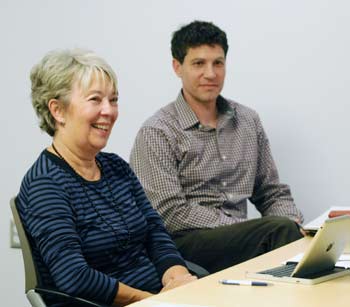Public Art Projects Move Forward
Ann Arbor public art commission meeting (April 23, 2014): A major public art project for East Stadium bridges will be moving to the city council for approval, following a recommendation made at this month’s Ann Arbor public art commission meeting.

KT Tomey is working on a project to develop maps for walking or running tours of public art in Ann Arbor. (Photos by the writer.)
“Arbor Winds” by Massachusetts artist Catherine Widgery features elevated, stand-alone louvered glass columns that are etched with images of trees – three on each end of the bridges, on the north side of Stadium Boulevard. The same type of louvered glass panels will also be used under the bridge along South State, affixed to the wall of the underpass – five sets on each side of South State Street. The overall project has a budget of $400,000 and has been in the works since 2011. If approved by council, it will likely be installed in 2015.
Commissioners also expressed enthusiasm for a new effort proposed by KT Tomey, who hopes to develop a mobile app for walking or running routes that highlight public art in Ann Arbor and on the University of Michigan campus. As a runner herself, she noted that people look for running routes when they visit new towns. So the app could be used to promote public art both to visitors and residents alike. Her first step is putting together .pdf maps that will be downloadable from AAPAC’s website.
Another new proposal prompted concerns about process. On the day of the meeting, John Kotarski – AAPAC’s vice chair – circulated an email to commissioners proposing that the city accept three pieces of donated art from Jim Pallas, an established Michigan artist and friend of Kotarski’s. The pieces are proposed to be located in the lobby of the Justice Center, in the atrium of city hall, and outside of city hall. Although commissioners seemed supportive of the idea, some expressed concern that the proposal wasn’t following AAPAC’s guidelines for accepting gifts of art, which include setting up a review committee.
Kotarski pointed out that Pallas is 75 years old. He noted that if artists donate artwork before they die, they can deduct the cost of materials from their taxes. But after they die, their estate is taxed on the market value of that artwork. “So these artists, at this point in their lives, have a financial incentive to find a good place for their artwork,” he said. “If we can make that process simple and easy for Jim – and pleasant – then I’m sure he’s willing to go to his friends” and encourage them to donate too.
He reported that the Ann Arbor Downtown Development Authority has offered a $500 honorarium to Pallas for each donated piece. Kotarski said the three pieces have a total estimated value of $100,000. He also mentioned that Pallas’ daughter, a law professor, knows city attorney Stephen Postema and that they’ve “made arrangement to resolve any legal issues necessary to facilitate this donation.”
Kotarski told commissioners that he’s tried to assure Pallas that this will work out, but “that’s why I’m a little nervous giving him these assurances, only to have this fall through at the last minute. That’s not going to be pleasant.”
Marsha Chamberlin said she recognized the benefits of encouraging Michigan artists to donate their work. “But we are a public body, and we have procedures. I just think it’s important that we observe those rules because we don’t want to make an exception for one thing, then hold someone’s feet to the fire for something else.”
Commissioners agreed that AAPAC chair Bob Miller would work with Aaron Seagraves, the city’s public art administrator, to set up a gift selection committee to review this proposal and make a recommendation to AAPAC.
In other action, the commission approved its annual art plan for fiscal 2015, which begins on July 1, 2014. The plan includes projects that are already underway, as well as proposed capital projects to be enhanced with public art. The ongoing projects are: (1) artwork for East Stadium bridges; (2) public art at Arbor Oaks Park; (3) Canoe Imagine Art; and (4) the Coleman Jewett memorial. The proposed enhanced capital projects are street and sidewalk stamping, painting or stenciling in four locations to be determined, for a total cost of $30,000. The city council would need to approve these projects before they would move forward.
Commissioners also approved applying for a $10,000 National Endowment for the Arts Challenge America Fast Track grant. The money, if awarded, would require matching funds in an equivalent amount from other sources for a public art project at Arbor Oaks Park in southeast Ann Arbor, located near Bryant Elementary School and the Bryant Community Center.
Fundraising continues for the Coleman Jewett memorial at the Ann Arbor farmers market, but Canoe Imagine Art has stalled. The community art project is intended as a temporary art display in downtown Ann Arbor using old canoes from the city that would be repurposed as public art. The city had hoped that the Ann Arbor Convention & Visitors Bureau would take administrative responsibility for the project, but the CVB has declined. Chamberlin, who’s taking the lead on this effort, said that if workarounds can’t be found for some of the administrative issues, “we have to kiss this project good-bye.” [Full Story]




